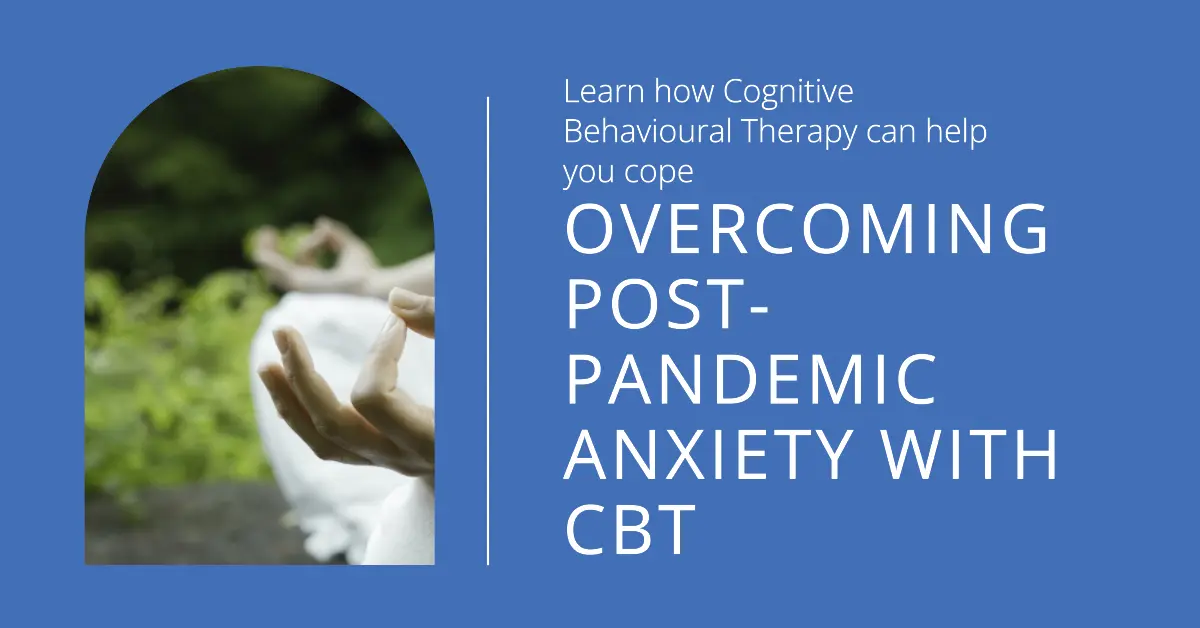Introduction
In the wake of the global pandemic, a new challenge has emerged for many: navigating the complex and often unsettling terrain of post-pandemic anxiety. This specific form of anxiety, born out of the unique circumstances of the COVID-19 crisis, has become a prevalent concern in our society. As we adapt to a world that is gradually returning to normalcy, understanding and managing these newfound anxieties is crucial for our mental well-being. This is where Cognitive Behavioral Therapy (CBT) comes into play – a well-established, evidence-based approach that offers powerful tools to combat anxiety. CBT focuses on altering negative thought patterns to effect positive change in emotions and behaviors. In this comprehensive guide, we’ll delve deep into how CBT can be a beacon of hope for those struggling with the lingering effects of the pandemic.
Understanding Post-Pandemic Anxiety
Post-pandemic anxiety isn’t merely a buzzword; it’s a lived reality for many individuals. It manifests in various forms, ranging from heightened health concerns to social anxiety stemming from prolonged periods of isolation. The unpredictability and stress of the pandemic have left indelible marks on our collective mental health. Common symptoms of this anxiety include excessive worry, sleep disturbances, an overwhelming sense of fear about the future, and difficulty adjusting to post-lockdown life.
The roots of this anxiety lie in the profound impact of the pandemic – a global event that disrupted our daily lives, instilled a pervasive sense of fear, and created a lingering uncertainty about the future. The sudden changes in our lifestyle, the loss of loved ones, the inundation of negative news, and the economic downturn have collectively contributed to a widespread sense of unease and anxiety.
The Basics of CBT
Cognitive Behavioral Therapy is distinct in the realm of psychotherapy for its structured, goal-oriented approach. It is based on the principle that our thoughts, feelings, and behaviors are intricately interconnected. Negative and irrational thought patterns, which are often a core feature of anxiety, can lead to detrimental emotions and actions. CBT aims to identify, challenge, and ultimately change these harmful thoughts, paving the way for healthier patterns of thinking and behaving.
Unlike some forms of therapy that delve deeply into the past experiences of individuals, CBT is more present-focused, dealing with current thoughts and behaviors. This makes it particularly effective and practical for addressing specific anxiety issues associated with the post-pandemic world.
CBT Techniques for Managing Anxiety
One of the strengths of CBT is its array of techniques, which are tailored to the individual needs of clients. Cognitive restructuring, for instance, involves identifying irrational beliefs and challenging them. This process helps replace these beliefs with more balanced, realistic thoughts. Exposure therapy, another key technique, gradually exposes individuals to anxiety-provoking situations in a controlled and systematic manner. This helps them build resilience over time and reduces their anxiety.
For example, someone who has developed a fear of crowded spaces post-pandemic might start by imagining being in such a space, then progress to viewing pictures, and eventually visit a real crowded place. This gradual exposure helps reduce the fear and anxiety associated with the situation.
Applying CBT in Daily Life
Incorporating CBT into daily life can start with simple practices. One effective practice is mindfulness, which involves being fully present in the moment and observing one’s thoughts and feelings without judgment. This can help reduce the spiral of anxious thoughts. Keeping a thought diary is another useful technique. In this diary, one can record negative thoughts, the situations in which they occur, and the emotions they trigger. This process can provide valuable insights into the patterns and triggers of one’s anxiety.
Over time, these self-help techniques, when practiced regularly, can significantly alleviate symptoms of post-pandemic anxiety. They empower individuals by providing them with tools to manage their anxiety and a sense of control over their mental health.
Challenges and Solutions in Post-Pandemic Anxiety
While CBT offers effective strategies for managing anxiety, it is not without its challenges. A significant hurdle is the tendency for individuals to fall back into old, negative thought patterns. To counter this, regular practice and reinforcement of CBT techniques are crucial. Another challenge is the pervasive and overwhelming nature of pandemic-related anxiety. To manage this, breaking down these anxieties into smaller, more manageable parts can be helpful.
Additionally, it’s important to set realistic expectations. Change does not happen overnight, and it’s normal to experience setbacks. Patience and persistence are key in the journey of overcoming anxiety.
The Role of Professional Guidance
While self-help CBT techniques can be impactful, the guidance of a trained therapist can significantly enhance the effectiveness of the therapy. Therapists can offer personalized strategies, provide support, and monitor progress. This ensures that the therapy is aligned with the individual needs and goals of the client. Especially in cases of severe anxiety, professional intervention can be a crucial step towards recovery.
Success Stories and Encouragement
Many individuals have found solace and recovery through CBT in the post-pandemic period. These success stories serve as a testament to the effectiveness of the therapy and provide hope for those who are still in the throes of their struggle. Remember, the journey to overcoming anxiety is a process. With the right tools and support, it’s entirely achievable.
Conclusion
In conclusion, CBT offers a structured, practical, and effective approach to managing post-pandemic anxiety. Its focus on altering thought patterns provides a clear pathway to overcoming the anxieties that have surfaced in these unprecedented times. By understanding and applying CBT techniques, either independently or with professional support, individuals can regain control over their mental health and navigate life with renewed confidence and resilience.
FAQs
What is post-pandemic anxiety and how is it different from general anxiety?
Post-pandemic anxiety specifically refers to anxiety symptoms that have arisen or intensified due to the unique circumstances of the COVID-19 pandemic. This may include fears about health, social interactions, and adapting to changing circumstances. It differs from general anxiety in its triggers, which are closely linked to the experiences and uncertainties brought about by the pandemic.
Can CBT help with long-term anxiety issues, or is it just a short-term solution?
CBT is effective for both short-term relief and long-term management of anxiety. While it can provide immediate tools for coping with anxiety symptoms, its core aim is to instill lasting changes in thought patterns and behaviours, leading to long-term improvements in mental health.
Is CBT suitable for everyone experiencing post-pandemic anxiety?
CBT is a versatile therapy that can be tailored to suit a wide range of individuals. However, its suitability can vary depending on personal preferences, the severity of the anxiety, and individual responsiveness to therapy. It’s always recommended to consult a mental health professional to determine the best approach for your specific needs.
How can I start practising CBT techniques on my own?
Starting with mindfulness exercises and maintaining a thought diary are practical ways to begin. Additionally, there are various resources available, including books, online courses, and apps that guide you through CBT techniques. However, for a more tailored approach, seeking guidance from a CBT-trained therapist is advisable.
How long does it typically take to see results from CBT for post-pandemic anxiety?
The time frame for seeing results from CBT can vary widely among individuals. Some may notice improvements within a few weeks, while others may require several months. The key to effectiveness lies in consistent practice and application of the techniques learned in therapy or through self-help resources.






